Green Lawn was a fine example of something which still held its beauty despite its age and dilapidated condition. In fact, the run-down house attracted more attention than it would otherwise, as passers-by were drawn to its crooked doors and broken windows and wonder ‘who lived there?’ and ‘how did it get into this state?’ This is the hidden history of Green Lawn.
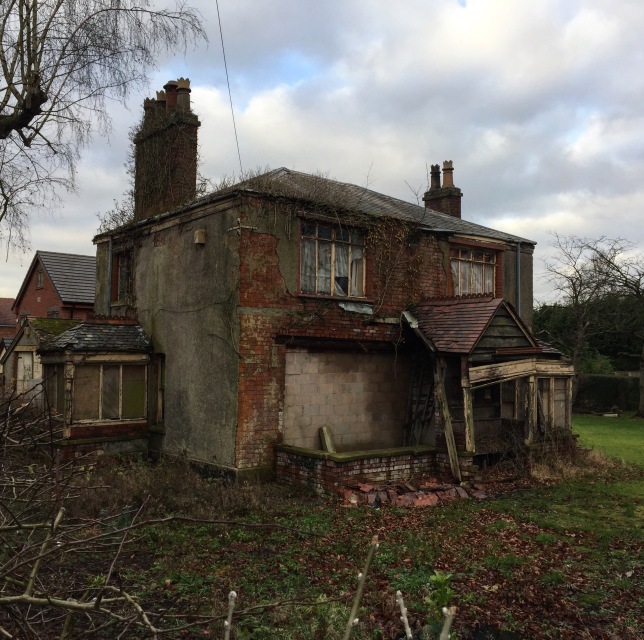
Where is Lowton?
Lowton is located in Greater Manchester, some 11 miles from Manchester city centre and 2 miles from Leigh. Lowton itself encompasses a large area including districts known as Lowton village, Lowton St. Mary’s, Lowton Common and Lane Head. It was first recorded in 1201 and like much of Lancashire, it was involved in the cotton spinning and silk weaving industries, although glue and sweets were also manufactured there.
In 1911, A County History of Lancaster, described Lowton as being “situated in flat uninteresting country, covered for the most part with bricks and mortar, for the very scattered town of Lowton spreads itself in every direction, leaving spaces only for pastures between the streets or groups of dwellings.” Despite this, it was still largely rural compared to neighbouring towns and in 1901 it had a population of only 2,964 persons.
The purpose of this post will focus on Green Lawn, a house situated in Lowton St. Mary’s. The area was named after the church established there in 1861 and also widely known for the train station which was located there between 1884-1964, itself only a short distance from Green Lawn.
Construction
I believe Green Lawn to have been constructed in the late 1850s or early 1860s, as it does not appear on the 1845-47 Ordnance Survey Map, nor the 1851 census but the first residents are recorded there in 1865. Although the current address of the property is 194 Newton Road, in the mid-nineteenth century the road was named Mather Lane. For the majority of the nineteenth and early twentieth centuries, Mather Lane was a prestigious residential location. Originally only home to some farms, large houses began to be built here in the first few decades of the nineteenth century; Lowton House (also referred to as Lowton Hall) and Sycamore House. After the construction of Green Lawn, houses such as; The Elms, Oaklands and the Vicarage completed the distinctively upper-middle class neighbourhood.
The first family to occupy Green Lawn was the Travers family. As a builder and contractor by trade, it is possible that Thomas Leigh Travers may have built the house himself. The house is quite unusual with a porch and bay windows to the front, however the porch does not contain the front door, but instead a bench where former residents could sit and enjoy their garden. The front door itself is located around the side of the property. The porch/seating area therefore gives the house a somewhat mid-nineteenth century ‘American’ feeling.
The name ‘Green Lawn’, is quite unusual, but it must signify the pride of the Travers family in their well-presented garden. Although a garden was common feature for large houses, the lawn itself was a symbol of status and wealth, as it showed the residents could afford the cost of maintaining their grounds, at a time when it was a physically demanding and therefore expensive task.
The Travers Family
The Travers family were an old Lowton family and Thomas Leigh Travers (1828-1891) had previously lived with his parents and siblings at Sycamore House in the early 1850s. Thomas Leigh Travers was the son of Thomas Travers (1796-1873) and Sarah Cross (b.1803) and his grandparents were Thomas Travers Esq. and Margery Leigh. His aunt, Sarah Travers, married William Hayes of Pennington and the Hayes cousins lived at Fairfield House on St. Helen’s Road. (A history of Fairfield, Leigh can be found here)
Thomas’s siblings were; Margaret Ann (b.1827), Sarah (b.1831), Mary (b.1833), Tabitha (b.1837), Catherine (b.1839) and William (b.1843), both Margaret Ann and Sarah taught as governesses in the 1850s. Although a reputable, and one of the few ‘respectable’ forms of employment for women in the nineteenth century, the role of a governess was a mixed blessing for a middle class family. For example, to employ a governess for the education of your children (normally daughters who remained at home) was a clear status symbol. However, to have a daughter become a governess would infer to wider society that you could not afford to keep her out of employment, or indeed that she had not yet made a suitable marriage and thus must support herself. Of course, teaching is and always has been a vocation, so perhaps Margaret Ann and Sarah enjoyed this role; although it could equally mean the Travers family finances had declined. Archival records seem to support the idea of a vocation, as the two sisters never married (as married women were not permitted to be teachers until 1919). Eventually, the sisters retired to house in Southport.
Thomas Leigh Travers
Thomas Leigh Travers was certainly up and coming in the mid-nineteenth century. In 1859 he married Mary Ann Foxcroft (1829-1902). The census of 1861 reveals they had a seven month old daughter, Edith Sarah and that Thomas was a timber merchant and builder by trade, employing ten men.
By 1865, Thomas and Mary Ann had moved to Green Lawn, having previously lived on Bond Street, Leigh. There, a son Thomas Wilmot Travers (b.1862) and another daughter, Marie Adeline (b.1866) completed the family. Also joining the household was a maid; fifteen year old Harriet Horton. Thomas was heavily involved in local society and he was elected on the Leigh Board of Guardians.
In December 1877 he organised a concert in aid of building a congregational church. Alongside members of Halle’s choir, seventeen year old Edith Sarah Travers played several pianoforte duets with Miss Green. Sadly, just a year later Edith passed away at only 18 years old. She is buried in Lowton St. Mary’s churchyard, just next to the front door (the funding of the church was by Miss Leigh, a cousin of the Travers family).

A New Start
“NEWTON-LE-WILLOWS – Genteel RESIDENCE, known as Green Lawn, situated in Lowton, comprising dining, drawing, and breakfast rooms, kitchen, pantry, bedrooms, &c., with orchard, with well-selected fruit trees, gardens, lawns, greenhouse with vines. The house is within easy distance of Kenyon and Pennington Stations. The Wigan line is also close contiguity. Will be Let singly, or with 10 statute acres of land, in good condition. To be entered in January next. Apply – Mr. T. L. Travers, Lowton, Newton-Le-Willows”
In November 1879, Green Lawn appeared in the local newspapers available for rent. Perhaps after the death of their daughter, Thomas and Mary Ann Travers felt they could no longer stay at the house. However, they did not move far, just further down Mather Lane to a house known as The Elms. The Elms was eventually inherited by Marie Adeline Travers and her husband Charles Guest. In 1921, Mr Guest unveiled the war memorial outside St. Mary’s church, as he and Marie had lost their only son during the First World War.
The new tenant of Green Lawn in March 1880 was Miss Elizabeth Johnson (1806-1886). She had previously lived with her elderly parents in a large house in Broughton, Salford before living independently in Eccles. Eventually she moved to Lowton, where her younger sister Mrs. Mary Johnson lived nearby at Kenyon Hall. Miss Johnson quickly established herself in the local community, especially with regards to spiritual and educational matters, particularly with the Wesleyan Methodists. She resided at Green Lawn with her housekeeper, Mary Webster.
Miss Johnson also employed a gardener, Mr. G. Marsh, to care for the extensive land surrounding Green Lawn. In September 1881 produce from the gardens was entered into the annual show of the Leigh Agriculture Association, which was held in a meadow next to the parish Church. As well awards for horses and cattle, poultry, pigeons, dogs, butter, farm and garden produce; there was also a horse-leaping contest, a display of modern agricultural implements, music by St. Joseph’s Brass Band and a luncheon for 300 to 400 ladies and gentlemen. Miss Johnson was awarded second prize across three categories, for her grapes, apples and plums.
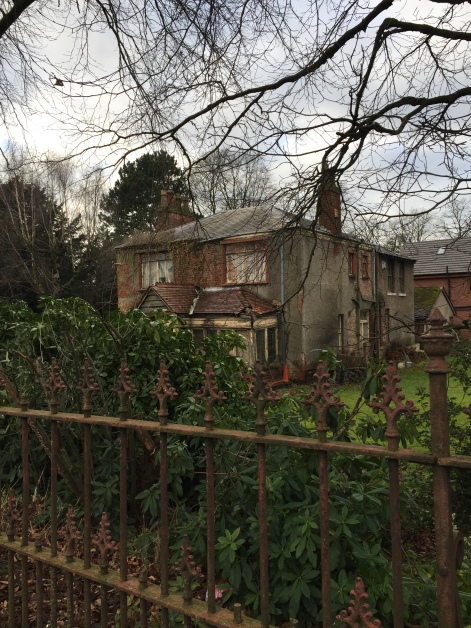
Sadly on 16 January 1886, Miss Johnson passed away quite suddenly, after a brief spell of bronchitis. The local newspaper, The Leigh Chronicle, reflected on the popularity of Miss Johnson on her passing. They noted:
” It may be said with truth that she sacrificed herself for the good of the people…The deceased lady was generally beloved throughout the entire village, and her death has cast a gloom over the neighbourhood. She was known in every part of the district as generous and kindhearted, and in no one instance can it be said that at any time she cheerfully refused to help the needy… In this, as in many other respects a great loss is universally felt, and all classes of the community will ever remember her kindly greetings.”
Miss Johnson was buried in the Wesleyan Cemetery at Cheetham Hill, her coffin transported there by train from Lowton St. Mary’s Station and the road from Green Lawn to the station was lined with mourners paying their respects.
Green Lawn in the 1880s
Upon Miss Johnson’s death her estate, valued at £4004/13s/5d (over £400,000 in modern terms) was left to be divided between two of her nephews. As an unmarried woman with no dependants, her household furniture and goods were sold by auction at the house in February 1886. Auctions of household items were quite common across the nineteenth century, particularly after a death, a decline in financial situation, or a downsizing in property.
However, the notice of auction provides us with a snapshot of how Green Lawn would have looked in the mid-1880s, without the need for any photographic material. Green Lawn exuded a luxurious and comfortable home. The drawing room and dining room both had Brussels carpets and woollen hearth rugs, both rooms were located at the southern facade of the house with the bay windows and had woollen drapery (to keep the heat in) and sunshades (to keep the sunlight out). Also in the drawing room was a mahogany sofa covered in crimson, eight matching chairs, a glass decanter set, a card table and a decorative gilt frames and 50 inch by 46 inch “chimney glass” (a mirror).
The dining room had a small library of books, a mahogany sideboard, eight mahogany chairs covered in Moroccan crimson leather, two gents easy chairs and a lady’s easy chair and footstools. In one of the four bedrooms there was a mahogany Tudor-style bed for sale, and also various wardrobes, chest of drawers, dressing tables, chairs, commodes, a bidet, nightstands and mirrors. In the kitchen a pembroke table was to be found, alongside a kitchen dresser, a set of seven drawers, brass preserving and saucepans, earthenware, a wringing machine, dolly and wash tubs and copper and iron kettles. Although only a brief glimpse into the house, its gives us an idea of how the rooms were set, what household activities took place and what constituted a comfortable, middle-class home.
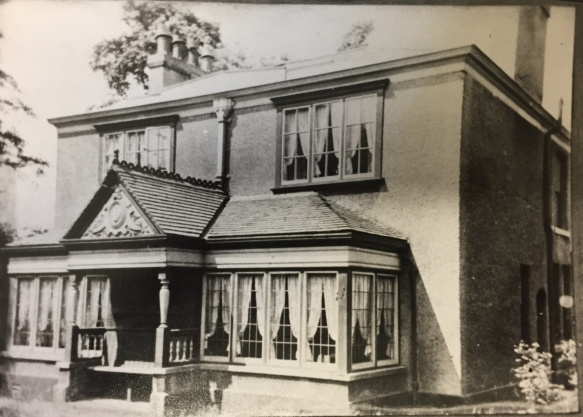
The house was advertised to let again in 1886 and it was occupied by Harriet Greenhalgh. Not much is known about Harriet but she does appear on the electoral register for the property in 1889. This means Harriet, who rented Green Lawn, must have been unmarried and a rate payer. The Local Government Act 1888 had reformed rural governments and provided county councils. Significantly another term of the Act was that it allowed unmarried female property owners and rate payers, like Harriet, to vote in county elections (but still not parliamentary elections, which would not come until 1918). Later in 1889, Green Lawn was once again advertised to be let, this time is was described as a “desirable country residence “, which infers Lowton was still largely undeveloped at this time.
A Contested Will
By the 1890s Green Lawn had changed from one of the largest houses on Mather Lane, to a more modest family home. In 1890, William Procter (1861-1906), a secretary for Ackers, Whitley and Co. at Bickershaw Colliery, lived there with his wife, Alice (1862-1901). The Procter’s were still able to afford a live-in servant. In 1891 this was 25 year old Teresa Gillis from Dublin. By 1901 however, the household consisted of William and Alice, Jane Wright (Alice’s 75 year old mother), Jane Procter (an 11 year old niece) and a maid, Martha Sweetlove.
Unfortunately the start of a new century was not an optimistic or bright one for the Procters. In August 1901, Alice Procter died aged only 38 after a long illness and she was buried at Blackpool. In 1903, William Procter left Green Lawn and in 1904 the house again was advertised to rent. In January 1906, he passed away aged 45. In his will dated 1904 he left his estate of £1500 (£148,000) to his sister, with the exception of £25 to his maid. However, a second will was produced dated 1903, in which he left his entire estate to his niece who lived him at Green Lawn. The case made it to court, but fortunately the executor of the 1903 will agreed not to contest the later will and agreed to pay a third of the estate to the niece.
The Early Twentieth Century
In 1904 the Jackson family moved into Green Lawn. Not long after they moved in, the house was extended at the rear. Joseph Jackson (b.1852) was a legal clerk and he lived at Green Lawn with his wife Margaret (b.1854). The couple had seven children together but in 1911 only three remained at home with their parents: Margaret Katherina (b.1886), Reginald (b.1890) and Sydney (b.1895).
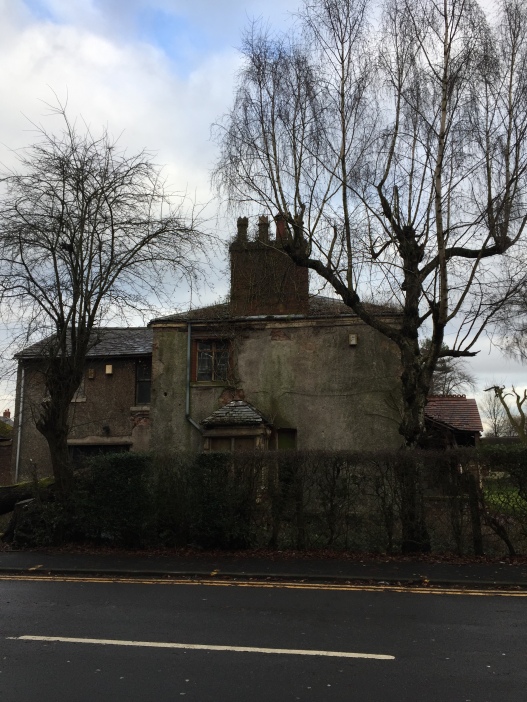
As with previous residents of Green Lawn, the Jacksons were prominent in local society. In 1910, Joseph and Margaret were invited to a reception held by Mayor W. J. Smith in Leigh. By 1913 the family had left Green Lawn and the house was once again advertised in the local newspapers, however this time it was available to buy or rent, as presumably the Travers family no longer desired to keep it.
The Green Family
The new owners of Green Lawn did not move far to get there, in fact they moved from the house next door. Oaklands is a substantial Victorian property built in 1883, just across Hesketh Meadow Lane from Green Lawn. It was occupied by the Green family. John Green was a farmer and soap and glue manufacturer. He lived at Oaklands with his wife Anne, his three children from his first marriage; William, Alfred and Frederic and his children from his second marriage; Beatrice and Philip, as well as two servants.
After their father’s death in 1893, William Lees Green and his brother Alfred and Frederic inherited their father’s soap and glue business. In 1908, William Lees Green (b.1865) married Rose Agnes de Braunstein (nee Monaghan). Rose appears to have had an anything but ordinary life. She was born in 1876 in Shipley, Yorkshire, the daughter of Irish labourers. At some point in the 1890s she married an elusive character, Colonel de Braunstein (supposedly of the Russian army) and they had three children together; Violet (b.1895 in York), Kathleen (b.1897 in Leeds or Germany depending on sources) and Nicholas (b.1899 in Algeria). In 1901 Rose was classified as a widow, living back in Yorkshire with her three children, father, brother, servant and lodger.
The 1911 census reveals, Rose and William had started their married life together but her children were all in boarding schools. The two daughters were students at St. Mary’s Orphanage. However, they were at the secondary school there and therefore the census records them as “pupils” compared to the younger girls who were classified as “inmates”. Her son, Nicholas was a pupil at Thorncliffe, a Catholic boys school in Middlesbrough. What happened to Rose’s daughters after their schooling remains unknown, although it appears Violet travelled extensively, visiting New York in 1925 and Buenos Aries in 1931.
After 1913, William and Rose settled into Green Lawn, although it was a tragic final few years for the family. In July 1917, Nicholas de Braunstein passed away at Green Lawn aged 17, having resided there for some time with his mother and step-father. He is buried in St. Mary’s Church yard, Lowton. The following year, in July 1918, William was forced to declare himself bankrupt and shortly after this, Rose died on October 25th. In June 1920, William himself died aged only 55 years old and was buried with his wife and step-son. He left his brother Alfred all that he had, which was just £5.
The Twentieth Century & Beyond
Between 1921 and 1924, Green Lawn was occupied by Fred Brooks. In 1925 it was purchased by John Stocks Kilshall (1865-1932) and his wife Lillie (1869-1947). John and Lillie Kilshall had previously been farmers at New Bradley Farm in Burtonwood, however as they were in their early sixties when they moved to Green Lawn, we can surmise they were downsizing.
In 1929 their only child, Doris married Eric Hugh Roberts (1899-1994). The young married couple lived with John and Lillie. In 1939, Lillie was recorded as the head of the family, living on private means and Eric’s occupation was within Local Government. Doris and Eric had a son, Ronald born in 1935.
By the 1950s, Doris and Eric were still living at Green Lawn, as the postcard below testifies. By this time Eric’s occupation had changed to an estate agent. The couple remained at Green Lawn for many decades; Doris passed away in 1987 and Eric in 1994. After this, the house was occupied by their son Ronald and his family before the property eventually became empty.
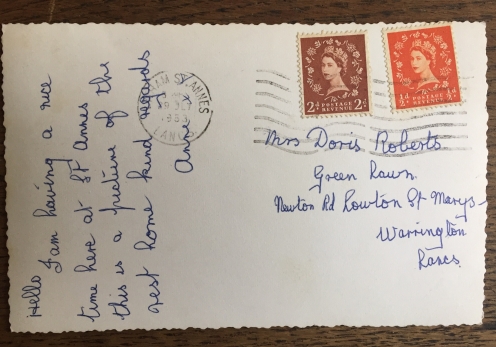
For the last few years, Green Lawn stood unoccupied, and as such it became abandoned and dilapidated. Until a few years ago, the house was hidden from the public view on the busy Newton Road, however when the trees were cut down, this decaying grand house was revealed and it enchanted passers-by. Apart from the obvious condition of the porch and bay windows, the house appeared to be in a stable condition.
Nonetheless, the site was earmarked for development, a fate which befalls many of our older houses. Just like its neighbours; The Elms, Sycamore House and Lowton House, permission was granted in 2017 to demolish Green Lawn and replace it with two modern houses. This project has also stalled as the site of the house is earmarked for the future Hs2 railway. The line will cut right through the current garden.
If the walls of Green Lawn could talk, they would spill many more facts, anecdotes and secrets of former years. Sadly, the house was demolished in October 2019.
Researched and Written by Thomas McGrath
~
Sources:
- Leigh Chronicle, 1 April 1865, p.2
- Leigh Chronicle, 15 April 1865, p.2
- Leigh Journal, 22 December 1877, p.8
- Wigan Observer, 1 November 1879, p.4
- Northwich Guardian, 17 September 1881, p.6
- Leigh Chronicle, 22 January 1886, p.5
- Leigh Chronicle, 12 February 1886, p.3
- Leigh Chronicle, 9 April 1886, p.4
- Leigh Chronicle, 6 September 1889, p.4
- Leigh Chronicle, 23 August 1901, p.5
- Leigh Chronicle, 23 October 1903, p.4
- Leigh Chronicle, 11 March 1904, p.5
- Leigh Chronicle, 20 July 1906, p.3
- Leigh Chronicle, 11 February 1910, p.3
- Leigh Chronicle, 5 December 1913, p.1
- Manchester Evening News, 10 July 1917, p.4
- ‘Townships: Lowton’, in A History of the County of Lancaster: Volume 4, ed. William Farrer and J Brownbill (London, 1911), pp. 150-154.
- https://www.thegazette.co.uk/London/issue/30905/page/11128/data.pdf
- https://www.thegazette.co.uk/London/issue/39300/page/4135/data.pdf
- http://www.lan-opc.org.uk/
- https://www.measuringworth.com/ukcompare/
- http://www.findmypast.co.uk
- http://www.ancestry.co.uk
- Wigan Archives & Leigh Local Studies

Fascinating article. I have lived in Lowton all my life and have often wondered about the history of this house. A significant amount of time has clearly been spent researching and compiling this. Many thanks for sharing it. It would be interesting to know further details surrounding the post 1950 period, and why the house sadly deteriorated to its current state.
Are there any plans to produce similar articles detailing the other adjacent houses, some of which are now demolished?
LikeLiked by 1 person
Thank you for your kind comments, since posting the article I’ve updated it with new details concerning the house until the 1990s. I shall continue to update it as I discover more.
I do have some plans to write about the other houses on Newton Road, they’re currently in the pipeline!
LikeLike
In 2016 Ronald was still living there until his stroke.
LikeLiked by 1 person
Thanks John, it’s like a jigsaw puzzle – I’m always finding new pieces!
LikeLike
OAKLANDS -opposite Green Lawns -now under offer for ‘Development’ – most likely demolition – is listed as a building of interest in Pevsner’s “The Buildings of England – LANCASHIRE:-Liverpool and the South West” edition:-
OAKLANDS, No. 196 Newton Road.
A big villa dated 1883. Pressed red brick, turret and bays, with some Gothic details (e.g. vine scroll), and wooden panelling and panelled ceilings. The staircase is lit by a painted-glass window with Pre-Raphaelite women.
Perhaps you could photograph that building before it disappears?
LikeLike
Thanks for the information Tom! It would be such a shame to lose this property as well, although as it’s owned by the council still, it is very hard to get access to the house. I shall try my best to record the history before its too late.
LikeLike
Thank you for a most interesting and informative article .
LikeLiked by 1 person
Absolutely fascinating, we have always wonder about the history of this ornate house and it’s original iron railings which it retained, when most others were removed in the 1940s supposedly to help the war effort. We look forward to your next project.
LikeLiked by 1 person
Thank you for sharing the history of Green Lawns I was born and bred in Lowton St Marys and often wondered about the people who had lived their
LikeLiked by 1 person